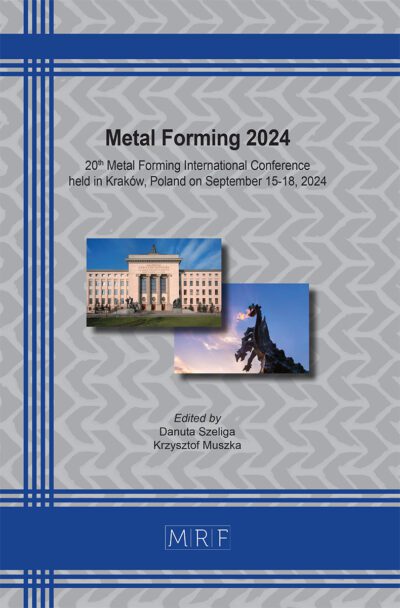–
Computational thermo-mechanical process design by integrating crystal plasticity and phase field model
MIN Kyung Mun, BONG Hyuk Jong, LEE Myoung-Gyu
download PDFAbstract. An integrated model, merging the crystal plasticity finite element model (CPFEM) and the phase field model (PFM), is introduced for simulating the thermo-mechanical processing of ultra-low carbon steels. CPFEM serves as the mechanical simulation tool, forecasting deformation inconsistencies such as local stress concentration, inhomogeneous dislocation distribution, and shear bands. Meanwhile, PFM is utilized for predicting microstructural evolution, particularly nucleation and growth during heat treatments. To seamlessly integrate CPFEM and PFM, which are based on the finite element and finite difference methods respectively, an optimized coupling algorithm is utilized to avoid excessive computational cost. Importantly, a generalized strain energy release maximization model is integrated into the PFM, which leverages the analytical outcomes of CPFEM to predict the recrystallization texture of steels, factoring in multiple slip activities under mechanical loading conditions. The proposed model is applied to evaluate the anisotropy and formability of the thermo-mechanically processed ultra-low carbon steel through virtual mechanical experiments.
Keywords
Crystal Plasticity, Phase Field Model, Recrystallization, Anisotropy, Formability
Published online 4/24/2024, 10 pages
Copyright © 2024 by the author(s)
Published under license by Materials Research Forum LLC., Millersville PA, USA
Citation: MIN Kyung Mun, BONG Hyuk Jong, LEE Myoung-Gyu, Computational thermo-mechanical process design by integrating crystal plasticity and phase field model, Materials Research Proceedings, Vol. 41, pp 2200-2209, 2024
DOI: https://doi.org/10.21741/9781644903131-242
The article was published as article 242 of the book Material Forming
![]() Content from this work may be used under the terms of the Creative Commons Attribution 3.0 license. Any further distribution of this work must maintain attribution to the author(s) and the title of the work, journal citation and DOI.
Content from this work may be used under the terms of the Creative Commons Attribution 3.0 license. Any further distribution of this work must maintain attribution to the author(s) and the title of the work, journal citation and DOI.
References
[1] M.E. McHenry, D.E. Laughlin, Magnetic Properties of Metals and Alloys, in: Physical Metallurgy, Elsevier, 2014, pp. 1881–2008. https://doi.org/10.1016/B978-0-444-53770-6.00019-8
[2] T. Urabe, High Formability Steel, in: Encyclopedia of Materials: Metals and Alloys, Elsevier, 2022, pp. 3–11. https://doi.org/10.1016/B978-0-12-819726-4.00131-9
[3] S.K. Paul, S. Mishra, On the formability of sheet steels, Bull. Mater. Sci. 19 (1996) 963–984. https://doi.org/10.1007/BF02744631
[4] K.S. Chan, Effects of plastic anisotropy and yield surface shape on sheet metal stretchability, Metall. Trans. A 16 (1985) 629–639. https://doi.org/10.1007/BF02814237
[5] Z. Marciniak, K. Kuczyński, Limit strains in the processes of stretch-forming sheet metal, Int. J. Mech. Sci. 9 (1967) 609–620. https://doi.org/10.1016/0020-7403(67)90066-5
[6] H.J. Bong, J. Lee, X. Hu, X. Sun, M.G. Lee, Predicting forming limit diagrams for magnesium alloys using crystal plasticity finite elements, Int. J. Plast. 126 (2020) 102630. https://doi.org/10.1016/j.ijplas.2019.11.009
[7] C.P. Kohar, J.L. Bassani, A. Brahme, W. Muhammad, R.K. Mishra, K. Inal, A new multi-scale framework to incorporate microstructure evolution in phenomenological plasticity: Theory, explicit finite element formulation, implementation and validation, Int. J. Plast. 117 (2019) 122–156. https://doi.org/10.1016/j.ijplas.2017.08.006
[8] I. Steinbach, F. Pezzolla, A generalized field method for multiphase transformations using interface fields, Phys. D 134 (1999) 385–393. https://doi.org/10.1016/S0167-2789(99)00129-3
[9] S.G. Kim, D.I. Kim, W.T. Kim, Y.B. Park, Computer simulations of two-dimensional and three-dimensional ideal grain growth, Phys. Rev. E 74 (2006) 061605. https://doi.org/10.1103/PhysRevE.74.061605
[10] D.N. Lee, The evolution of recrystallization textures from deformation textures, Scr. Metall. Mater. 32 (1995) 1689–1694. https://doi.org/10.1016/0956-716X(95)00256-U
[11] D.N. Lee, Strain energy release maximization model for evolution of recrystallization textures, Int. J. Mech. Sci. 42 (2000) 1645–1678. doi.org/10.1016/S0020-7403(99)00095-8
[12] D.N. Lee, Texture and related phenomena, second ed., The Korean Institute of Metals and Materials, Seoul, 2014.
[13] K.M. Min, W. Jeong, S.H. Hong, C.A. Lee, P.-R. Cha, H.N. Han, M.-G. Lee, Integrated crystal plasticity and phase field model for prediction of recrystallization texture and anisotropic mechanical properties of cold-rolled ultra-low carbon steels, Int. J. Plast. 127 (2020) 102644. https://doi.org/10.1016/j.ijplas.2019.102644
[14] F.J. Humphreys, M. Hatherly, Recrystallization and Related Annealing Phenomena, second ed., Elsevier, 2004. https://doi.org/10.1016/B978-0-08-044164-1.X5000-2
[15] H. Zurob, Y. Brechet, J. Dunlop, Quantitative criterion for recrystallization nucleation in single-phase alloys: Prediction of critical strains and incubation times, Acta Mater. 54 (2006) 3983–3990. https://doi.org/10.1016/j.actamat.2006.04.028
[16] H. Rodney, A theory of the yielding and plastic flow of anisotropic metals, Proc. R. Soc. Lond. A Math. Phys. Sci. 193 (1948) 281–297. https://doi.org/10.1098/rspa.1948.0045
[17] F. Barlat, J.C. Brem, J.W. Yoon, K. Chung, R.E. Dick, D.J. Lege, F. Pourboghrat, S.-H. Choi, E. Chu, Plane stress yield function for aluminum alloy sheets—part 1: theory, Int. J. Plast. 19 (2003) 1297–1319. https://doi.org/10.1016/S0749-6419(02)00019-0
[18] Metallic materials-Sheet and strip-Determination of forming-limit curves-Part 2: Determination of forming-limit curves in the laboratory, International Organization for Standardization, 2008.














